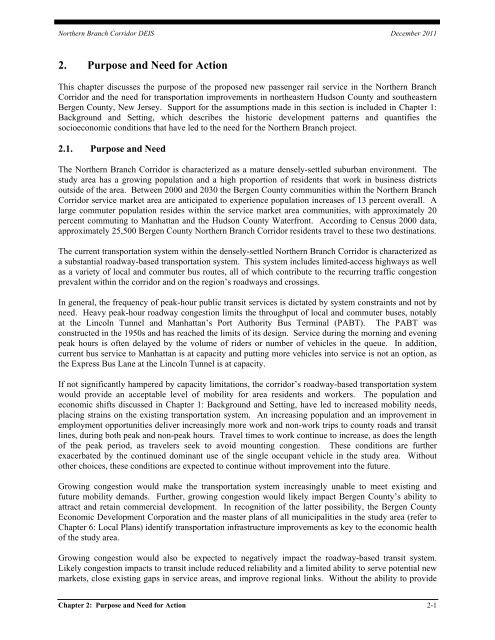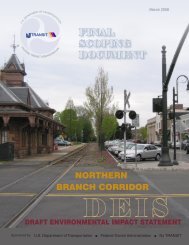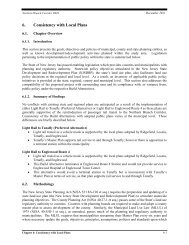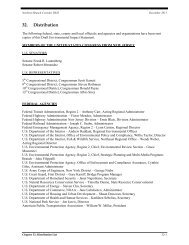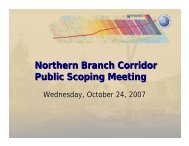2. Purpose and Need for Action - Northern Branch Corridor Project
2. Purpose and Need for Action - Northern Branch Corridor Project
2. Purpose and Need for Action - Northern Branch Corridor Project
You also want an ePaper? Increase the reach of your titles
YUMPU automatically turns print PDFs into web optimized ePapers that Google loves.
<strong>Northern</strong> <strong>Branch</strong> <strong>Corridor</strong> DEIS December 2011<br />
<strong>2.</strong> <strong>Purpose</strong> <strong>and</strong> <strong>Need</strong> <strong>for</strong> <strong>Action</strong><br />
This chapter discusses the purpose of the proposed new passenger rail service in the <strong>Northern</strong> <strong>Branch</strong><br />
<strong>Corridor</strong> <strong>and</strong> the need <strong>for</strong> transportation improvements in northeastern Hudson County <strong>and</strong> southeastern<br />
Bergen County, New Jersey. Support <strong>for</strong> the assumptions made in this section is included in Chapter 1:<br />
Background <strong>and</strong> Setting, which describes the historic development patterns <strong>and</strong> quantifies the<br />
socioeconomic conditions that have led to the need <strong>for</strong> the <strong>Northern</strong> <strong>Branch</strong> project.<br />
<strong>2.</strong>1. <strong>Purpose</strong> <strong>and</strong> <strong>Need</strong><br />
The <strong>Northern</strong> <strong>Branch</strong> <strong>Corridor</strong> is characterized as a mature densely-settled suburban environment. The<br />
study area has a growing population <strong>and</strong> a high proportion of residents that work in business districts<br />
outside of the area. Between 2000 <strong>and</strong> 2030 the Bergen County communities within the <strong>Northern</strong> <strong>Branch</strong><br />
<strong>Corridor</strong> service market area are anticipated to experience population increases of 13 percent overall. A<br />
large commuter population resides within the service market area communities, with approximately 20<br />
percent commuting to Manhattan <strong>and</strong> the Hudson County Waterfront. According to Census 2000 data,<br />
approximately 25,500 Bergen County <strong>Northern</strong> <strong>Branch</strong> <strong>Corridor</strong> residents travel to these two destinations.<br />
The current transportation system within the densely-settled <strong>Northern</strong> <strong>Branch</strong> <strong>Corridor</strong> is characterized as<br />
a substantial roadway-based transportation system. This system includes limited-access highways as well<br />
as a variety of local <strong>and</strong> commuter bus routes, all of which contribute to the recurring traffic congestion<br />
prevalent within the corridor <strong>and</strong> on the region’s roadways <strong>and</strong> crossings.<br />
In general, the frequency of peak-hour public transit services is dictated by system constraints <strong>and</strong> not by<br />
need. Heavy peak-hour roadway congestion limits the throughput of local <strong>and</strong> commuter buses, notably<br />
at the Lincoln Tunnel <strong>and</strong> Manhattan’s Port Authority Bus Terminal (PABT). The PABT was<br />
constructed in the 1950s <strong>and</strong> has reached the limits of its design. Service during the morning <strong>and</strong> evening<br />
peak hours is often delayed by the volume of riders or number of vehicles in the queue. In addition,<br />
current bus service to Manhattan is at capacity <strong>and</strong> putting more vehicles into service is not an option, as<br />
the Express Bus Lane at the Lincoln Tunnel is at capacity.<br />
If not significantly hampered by capacity limitations, the corridor’s roadway-based transportation system<br />
would provide an acceptable level of mobility <strong>for</strong> area residents <strong>and</strong> workers. The population <strong>and</strong><br />
economic shifts discussed in Chapter 1: Background <strong>and</strong> Setting, have led to increased mobility needs,<br />
placing strains on the existing transportation system. An increasing population <strong>and</strong> an improvement in<br />
employment opportunities deliver increasingly more work <strong>and</strong> non-work trips to county roads <strong>and</strong> transit<br />
lines, during both peak <strong>and</strong> non-peak hours. Travel times to work continue to increase, as does the length<br />
of the peak period, as travelers seek to avoid mounting congestion. These conditions are further<br />
exacerbated by the continued dominant use of the single occupant vehicle in the study area. Without<br />
other choices, these conditions are expected to continue without improvement into the future.<br />
Growing congestion would make the transportation system increasingly unable to meet existing <strong>and</strong><br />
future mobility dem<strong>and</strong>s. Further, growing congestion would likely impact Bergen County’s ability to<br />
attract <strong>and</strong> retain commercial development. In recognition of the latter possibility, the Bergen County<br />
Economic Development Corporation <strong>and</strong> the master plans of all municipalities in the study area (refer to<br />
Chapter 6: Local Plans) identify transportation infrastructure improvements as key to the economic health<br />
of the study area.<br />
Growing congestion would also be expected to negatively impact the roadway-based transit system.<br />
Likely congestion impacts to transit include reduced reliability <strong>and</strong> a limited ability to serve potential new<br />
markets, close existing gaps in service areas, <strong>and</strong> improve regional links. Without the ability to provide<br />
Chapter 2: <strong>Purpose</strong> <strong>and</strong> <strong>Need</strong> <strong>for</strong> <strong>Action</strong> 2-1
<strong>Northern</strong> <strong>Branch</strong> <strong>Corridor</strong> DEIS December 2011<br />
reliable <strong>and</strong> comprehensive service, or to serve new markets, the transit system will remain at a<br />
competitive disadvantage with automobile commuting in the study area <strong>and</strong> will be ineffectual in ef<strong>for</strong>ts<br />
to reduce congestion.<br />
The purpose <strong>and</strong> need of the proposed project is to improve mobility within Hudson <strong>and</strong> Bergen Counties,<br />
alleviate some traffic congestion, <strong>and</strong> support continued economic growth.<br />
<strong>2.</strong><strong>2.</strong> Goals <strong>and</strong> Objectives<br />
Provisions of new transportation service in the <strong>Northern</strong> <strong>Branch</strong> <strong>Corridor</strong> would address the following<br />
goals <strong>and</strong> objectives:<br />
Goal 1: Meet the needs of travelers in the project area.<br />
Objectives:<br />
Attract riders to transit. A central goal of the project is to attract more riders to rail transit in<br />
the <strong>Northern</strong> <strong>Branch</strong> <strong>Corridor</strong>. In spite of its proximity to New York, eastern Bergen County<br />
continues to have high single occupancy vehicle commutation. The goal of re-introducing rail<br />
transit is to encourage a greater transit ridership both on opening day <strong>and</strong> into the future.<br />
<br />
<br />
<br />
<br />
Improve travel time. Travelers in the project area put a high value on their time, <strong>and</strong> are looking<br />
<strong>for</strong> travel options that will improve their travel time <strong>and</strong> reliability.<br />
Improve convenience. Travelers are looking <strong>for</strong> new travel options that will make traveling in<br />
the region more convenient. They are looking <strong>for</strong> frequent service, adequate parking at stations,<br />
competitive travel times, <strong>and</strong> convenient connections to other transit services, such as ferries,<br />
PATH, <strong>and</strong> feeder services.<br />
Provide more options <strong>for</strong> travelers. Today, travelers are severely limited in their travel options.<br />
Transit can be used <strong>for</strong> only a very small portion of the area’s travel needs. Travelers want more<br />
travel options to meet their diverse travel needs. Options could include service to many<br />
destinations, including Midtown Manhattan, Lower Manhattan, the Hudson River Waterfront,<br />
Newark, <strong>and</strong> recreational areas, such as the Sports Complex <strong>and</strong> the Jersey Shore, especially on<br />
weekends <strong>and</strong> at night.<br />
Improve services <strong>for</strong> low-income/minority/transit-dependent travelers. Transit-dependent<br />
residents in the project area need good transit options to more of the region’s jobs, not only the<br />
jobs in Manhattan, but growing employment centers in New Jersey, like the Hudson River<br />
Waterfront area, Newark, the Meadowl<strong>and</strong>s, <strong>and</strong> Bergen <strong>and</strong> Rockl<strong>and</strong> employment centers.<br />
Goal 2: Advance Cost-Effective Transit Solutions<br />
Objectives:<br />
Support favorable farebox recovery. For the vast majority of transit systems, fare revenue does<br />
not cover the cost of providing service. However, higher farebox recovery ratios allow transit<br />
agencies to maximize the amount of service that can be provided <strong>for</strong> the same dollar of public<br />
operating subsidy. One of the goals of the <strong>Northern</strong> <strong>Branch</strong> project is to introduce rail transit to<br />
the corridor in a manner that is sensitive to the need to minimize the operating subsidy required to<br />
run the service. This will help ensure that the provision of transit service in the corridor is<br />
financially sustainable.<br />
Chapter 2: <strong>Purpose</strong> <strong>and</strong> <strong>Need</strong> <strong>for</strong> <strong>Action</strong> 2-2
<strong>Northern</strong> <strong>Branch</strong> <strong>Corridor</strong> DEIS December 2011<br />
<br />
<br />
Advance cost-effective transit solutions. The objective is to advance a project that, from a costbenefit<br />
perspective, provides the greatest overall benefit at the lowest capital cost.<br />
Support future expansion, scalability <strong>and</strong> af<strong>for</strong>dability. The <strong>Northern</strong> <strong>Branch</strong> project should<br />
allow <strong>for</strong> future transit expansion while at the same time provide a solution that is af<strong>for</strong>dable to<br />
construct. With limited capital funds, the ability to advance projects in phases helps to keep the<br />
projects af<strong>for</strong>dable. <strong>Project</strong> scalability allows projects to be constructed without precluding<br />
future expansion projects. One of the criteria on which the <strong>Northern</strong> <strong>Branch</strong> project will be<br />
evaluated is the degree to which one phase of a project integrates into a more global planning<br />
ef<strong>for</strong>t <strong>for</strong> transportation improvement in the region.<br />
Goal 3: Attract growth <strong>and</strong> support development in Bergen <strong>and</strong> Hudson Counties, including the Hudson<br />
River Waterfront.<br />
Objectives:<br />
Provide transportation capacity to support growth. Population <strong>and</strong> employment growth in<br />
<strong>and</strong> around Bergen County <strong>and</strong> Hudson County is expected to continue in the future. Additional<br />
transportation capacity <strong>and</strong> new travel options will be needed to support this growth, providing<br />
access between the jobs in the counties <strong>and</strong> surrounding residential communities. Growing<br />
congestion will continue to have negative impacts on the area’s economy in the future.<br />
<br />
Help attract new businesses. Companies looking to locate new facilities or exp<strong>and</strong> existing<br />
facilities in Bergen County <strong>and</strong> Hudson County will be looking <strong>for</strong> assurances that steps are being<br />
taken to provide the area with new travel alternatives. One of the major assets of this area is its<br />
proximity to New York City <strong>and</strong> its role in sustaining the strength of the State Plan’s<br />
Metropolitan Planning Area. New transportation choices that improve access to New York <strong>and</strong><br />
the rest of the region will help Bergen County <strong>and</strong> Hudson County to maintain their competitive<br />
advantage in the region.<br />
Goal 4: Improve regional mobility <strong>and</strong> access.<br />
Objectives:<br />
Provide connections to a variety of locations within the region. With the one exception of<br />
Manhattan, Bergen County’s access to the rest of the region is almost entirely by auto, on<br />
highways that are becoming increasingly congested. With the completion of the Secaucus<br />
Transfer, the areas served by the Main, Bergen, <strong>and</strong> Pascack Valley lines now benefit from rail<br />
access to the growing Hudson River Waterfront area, to Newark, to Trenton, <strong>and</strong> to the major<br />
recreational attractions, like the Meadowl<strong>and</strong>s <strong>and</strong> the New Jersey Shore.<br />
Goal 5: Reduce roadway congestion.<br />
Objectives:<br />
Provide more travel options <strong>for</strong> travelers trying to avoid highway congestion. Major<br />
regional highways in the project area are heavily congested. There are a limited number of major<br />
highways, each serving intra-county <strong>and</strong> regional travel needs. Congestion in Bergen County is a<br />
growing problem, which is likely to become more serious in the future. Transit strategies are<br />
unlikely to substantially reduce congestion, but can provide useful new travel alternatives <strong>for</strong><br />
travelers trying to avoid congestion.<br />
Chapter 2: <strong>Purpose</strong> <strong>and</strong> <strong>Need</strong> <strong>for</strong> <strong>Action</strong> 2-3
<strong>Northern</strong> <strong>Branch</strong> <strong>Corridor</strong> DEIS December 2011<br />
Goal 6: Enhance the transit network.<br />
Objectives:<br />
Eliminate gaps in the rail network. Bergen County’s transit share <strong>for</strong> trips to Manhattan is<br />
lower than any other part of northern New Jersey. This is due to several gaps in the transit<br />
network serving the area. For example, there is no rail service in eastern Bergen County. The<br />
closest rail line is the Pascack Valley Line, which is west of the Hackensack River. This<br />
inconvenient <strong>and</strong> capacity-constrained line is not an option <strong>for</strong> most residents of eastern Bergen<br />
County. Also, rail service is infrequent during off-peak periods. Rail service is best to Lower<br />
Manhattan, via PATH <strong>and</strong> ferry, less effective to the Valley, between Canal Street <strong>and</strong> 34 th Street,<br />
via PATH, <strong>and</strong> most difficult to Midtown.<br />
<br />
Eliminate gaps in the bus network. The bus network in eastern Bergen County also has some<br />
gaps. First, the network only serves Midtown Manhattan. Also, in the easternmost parts of the<br />
County, there is little or no bus service. In the more central parts of the study area there are many<br />
bus routes. However, these routes are generally slow because they travel on local roads <strong>and</strong> make<br />
many stops along the route to pick up passengers.<br />
Chapter 2: <strong>Purpose</strong> <strong>and</strong> <strong>Need</strong> <strong>for</strong> <strong>Action</strong> 2-4


